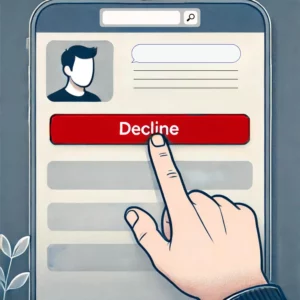Professional Boundaries
Table of Contents
In this post, we will be covering professional boundaries, task number eighteen on the RBT Competency Assessment. Professional boundaries are crucial in maintaining ethical and effective practice in Applied Behavior Analysis (ABA). They ensure that the relationship between the RBT and the client remains professional, focused, and free from conflicts of interest.
Welcome back to our RBT Competency Assessment blog post series! In this series, we are exploring each task on the RBT Competency Assessment to help new Behavior Technicians (BTs) prepare for their initial competency assessments and provide a valuable refresher for Registered Behavior Technicians (RBTs) renewing their certification.
We will discuss what professional boundaries are, why they are important in ABA, and key ways to maintain them. Additionally, we will provide real-world examples in both clinic and home-based settings to illustrate these principles in practice. By mastering the techniques to uphold professional boundaries, RBTs can ensure ethical and effective therapy sessions that promote positive outcomes for their clients. Let’s begin by defining professional boundaries and discussing their role and significance in ABA.
What are Professional Boundaries?
Definition and Explanation:
Professional boundaries refer to the clear and defined limits that are established to maintain a healthy, professional relationship between therapists and clients. These boundaries ensure that interactions remain professional, ethical, and focused on the client’s best interests. In the context of Applied Behavior Analysis (ABA), professional boundaries help prevent conflicts of interest, protect client confidentiality, and ensure that therapy is effective and unbiased.

Why are Professional Boundaries Important in ABA?
Role in Promoting Ethical and Effective Practice:
Maintaining professional boundaries is essential for promoting ethical and effective practice in ABA. Boundaries help ensure that the therapist-client relationship remains professional and focused on the client’s therapeutic goals. They prevent the development of inappropriate relationships that could compromise the effectiveness of therapy.
Impact on the Client-Therapist Relationship:
Professional boundaries help build and maintain trust between the client and the therapist. Clear boundaries create a safe and predictable environment where clients can feel secure and respected. This trust is crucial for effective therapy and positive outcomes.
Legal and Ethical Considerations:
Adhering to professional boundaries is a legal and ethical requirement in ABA. Ethical guidelines and professional standards mandate that therapists maintain appropriate boundaries to protect client rights and ensure the integrity of the therapeutic process. Violating these boundaries can lead to serious consequences, including legal action and loss of professional certification.
Key Ways to Maintain Professional Boundaries
Separation of Personal and Professional Relationships:
- Description: Keeping personal and professional relationships separate to avoid conflicts of interest.
- Example: Not socializing with clients or their families outside of therapy sessions. For instance, declining an invitation to a client’s family gathering to maintain professional boundaries.
Avoiding Dual Relationships:
- Description: Ensuring that roles do not overlap to maintain objectivity.
- Example: Not providing therapy to a family member or close friend. This ensures that personal relationships do not influence professional judgment.
Gifts and Personal Benefits:
- Description: Not accepting gifts or personal benefits from clients to avoid favoritism or obligation.
- Example: Politely declining a gift from a client’s family and explaining the professional guidelines. Instead, express gratitude verbally or with a thank-you note.
Social Media and Online Conduct:
- Description: Maintaining professional behavior and privacy online.
- Example: Not connecting with clients or their families on social media platforms. Instead, keep all interactions professional and therapy-related.
Physical Boundaries:
- Description: Respecting personal space and avoiding inappropriate physical contact.
- Example: Using appropriate touch only when necessary for therapy and with consent. For example, using hand-over-hand guidance for teaching a skill but ensuring the client is comfortable with the contact.
Financial Boundaries:
- Description: Keeping financial matters separate and transparent.
- Example: Not lending or borrowing money from clients or their families. Ensure all financial transactions related to therapy are handled through official channels.
Confidentiality in All Settings:
- Description: Maintaining client confidentiality in all interactions and environments.
- Example: Not discussing client details in public or non-secure settings. For instance, only discussing client information in private, secure locations and with authorized personnel.
Professionalism in Communication:
- Description: Using professional language and demeanor in all communications.
- Example: Keeping email correspondence clear, respectful, and focused on therapy-related topics. Avoiding informal language and maintaining a professional tone.
FAQ on Professional Boundaries
The following FAQ section consists of the four most Googled questions on the topic of professional boundaries in ABA.
- Q: What are examples of professional boundaries?
- A: Examples of professional boundaries include maintaining a professional relationship with clients, not accepting gifts, avoiding dual relationships, and keeping personal and professional lives separate.
- Q: What is an example of a professional boundary in ABA?
- A: An example of a professional boundary in ABA is not socializing with clients or their families outside of therapy sessions to avoid conflicts of interest and maintain objectivity.
- Q: How do you maintain professional boundaries as an RBT?
- A: Maintain professional boundaries by separating personal and professional relationships, avoiding dual relationships, respecting confidentiality, and ensuring all interactions are professional and focused on the client’s therapeutic goals.
- Q: What are two examples that would be violating professional boundaries?
- A: Examples of violating professional boundaries include accepting significant gifts from a client’s family and discussing personal issues or forming personal relationships with clients or their families outside of therapy sessions.
Final Thoughts
Maintaining professional boundaries is essential for ensuring ethical and effective practice in Applied Behavior Analysis (ABA). By upholding these boundaries, Registered Behavior Technicians (RBTs) can create a professional environment that fosters trust, respect, and positive therapeutic outcomes.
Understanding and implementing the key ways to maintain professional boundaries—such as separating personal and professional relationships, avoiding dual relationships, respecting confidentiality, and maintaining professionalism in communication—are vital skills for any RBT. By prioritizing these principles in all interactions, RBTs can ensure that their clients receive the highest quality care and support.
Remember, maintaining professional boundaries is not only an ethical obligation but also a crucial aspect of providing effective therapy. By mastering these techniques, RBTs can contribute to the overall well-being and progress of their clients while upholding the standards of the profession.
Explore More Resources
If you found this guide on maintaining professional boundaries in ABA helpful, be sure to explore more resources on our website. We offer a wealth of information, including detailed articles, study guides, and practical tips to help you succeed as a Registered Behavior Technician (RBT).
Are you preparing for the RBT competency assessment? Check out our comprehensive study materials and mock exams designed to help you ace the test and become a confident, competent RBT.
For more information on becoming a Registered Behavior Technician and for the latest research and resources in Applied Behavior Analysis, visit the Behavior Analyst Certification Board (BACB) website.
Share this blog with your peers and colleagues to spread the knowledge and support the ABA community!



